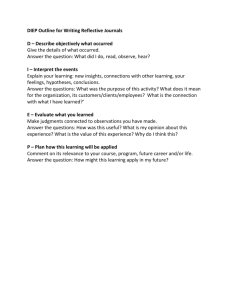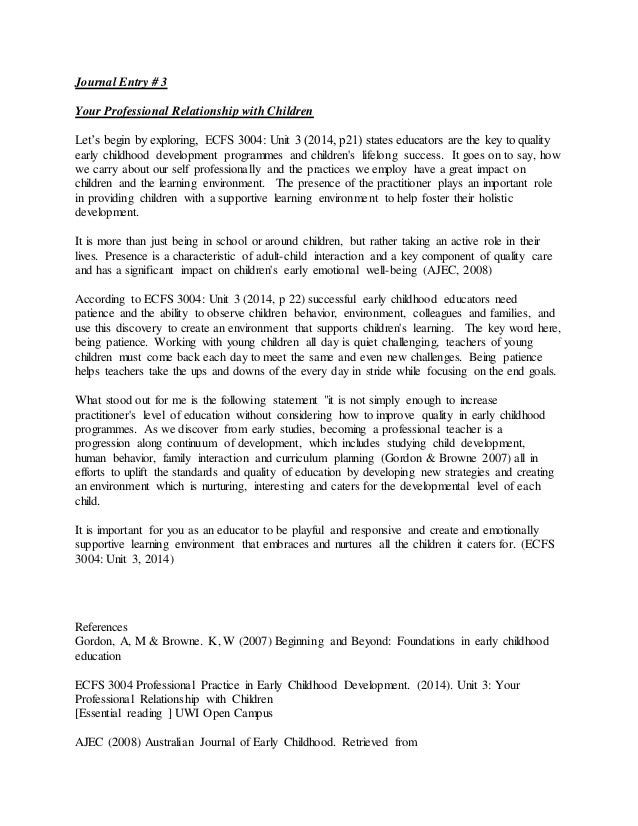
Sample Reflective Journal Template
keeping a reflective journal or learning log with multiple entries – particularly for professional placements – or be part of an essay or report. Reflective writing aims to get you to think about and understand your learning experiences. This outline is an approach to reflective writing, using a DIEP strategy. The DIEP strategy The DIEP DIEP Outline for Writing Reflective J ournals. D – Describe objectively what occurred. Give the details of what occurred. Answer the question: What did I do, read, observe, hear? I – Interpret the events. Explain your learning: new insights, connections with other File Size: 54KB Aug 07, · I-Interpret. Explain your personal interpretation of the learning you DESCRIBED. Identify new insights and epiphanies. Identify connections between your new learning with other learning and your emotional responses. Suggest hypotheses, explanations, and conclusions that you infer from your learning incident

Study skills
keeping a reflective journal or learning log with multiple entries – particularly for professional placements – or be part of an essay or report. Reflective writing aims to get you to think about and understand your learning experiences. This outline is an approach to reflective writing, using a DIEP strategy. The DIEP strategy The DIEP Study Tips: Reflective writing process. 2. DIEP STRATEGY. DIEP* is a strategy to help with writing a critical or academic reflection in four paragraphs. The four steps in this approach are to d escrib e an insight (new understanding), to in terp ret and evalu ate it, and to p lann how it might transfer to future practice or learning Reasons to Write a Reflective Journal. To understand the things that have happened. To reflect on why it happened this way. To align future actions with your values and lessons learned from your past experiences. To share and get your thoughts and ideas out of your head. Start a digital journal - download Journey app today!

Getting started at uni
Reasons to Write a Reflective Journal. To understand the things that have happened. To reflect on why it happened this way. To align future actions with your values and lessons learned from your past experiences. To share and get your thoughts and ideas out of your head. Start a digital journal - download Journey app today! keeping a reflective journal or learning log with multiple entries – particularly for professional placements – or be part of an essay or report. Reflective writing aims to get you to think about and understand your learning experiences. This outline is an approach to reflective writing, using a DIEP strategy. The DIEP strategy The DIEP Study Tips: Reflective writing process. 2. DIEP STRATEGY. DIEP* is a strategy to help with writing a critical or academic reflection in four paragraphs. The four steps in this approach are to d escrib e an insight (new understanding), to in terp ret and evalu ate it, and to p lann how it might transfer to future practice or learning

100,000+ Ready-Made Designs, Docs & Templates to Start, Run and Grow your Business
keeping a reflective journal or learning log with multiple entries – particularly for professional placements – or be part of an essay or report. Reflective writing aims to get you to think about and understand your learning experiences. This outline is an approach to reflective writing, using a DIEP strategy. The DIEP strategy The DIEP DIEP Outline for Writing Reflective J ournals. D – Describe objectively what occurred. Give the details of what occurred. Answer the question: What did I do, read, observe, hear? I – Interpret the events. Explain your learning: new insights, connections with other File Size: 54KB Aug 07, · I-Interpret. Explain your personal interpretation of the learning you DESCRIBED. Identify new insights and epiphanies. Identify connections between your new learning with other learning and your emotional responses. Suggest hypotheses, explanations, and conclusions that you infer from your learning incident

Personal Reflective Writing
Study Tips: Reflective writing process. 2. DIEP STRATEGY. DIEP* is a strategy to help with writing a critical or academic reflection in four paragraphs. The four steps in this approach are to d escrib e an insight (new understanding), to in terp ret and evalu ate it, and to p lann how it might transfer to future practice or learning Reasons to Write a Reflective Journal. To understand the things that have happened. To reflect on why it happened this way. To align future actions with your values and lessons learned from your past experiences. To share and get your thoughts and ideas out of your head. Start a digital journal - download Journey app today! 1. Describe the insight. An insight is something new that you learned or realised. The insight must be relevant to the course and ideally could change your thinking or behaviour in the future
No comments:
Post a Comment